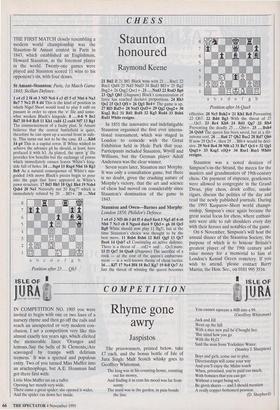CHESS
Staunton honoured
Raymond Keene THE FIRST MATCH closely resembling a modern world championship was the Staunton-St Amant contest in Paris in 1843, which established an Englishman, Howard Staunton, as the foremost player in the world. Twenty-one games were played and Staunton scored 11 wins to his opponent's six, with four draws.
St Amant-Staunton: Paris, 1st Match Game 1843; Sicilian Defence.
1 e4 c5 2 f4 e6 3 Nf3 Nc6 4 c3 d5 5 e5 Nh6 6 Na3 Bel 7 Nc2 f5 8 d4 This is the kind of position in which Nigel Short would tend to play 8 exf6 en passant in order to open the 'e' file and some- what weaken Black's !ringside. 8 -.0-0 9 Bet Bd7 10 0-0 Rc8 11 Khl cxd4 12 cxd4 Nt7 13 Rgl The commencement of a faulty plan. St Arrant believes that the central battlefield is quiet, therefore he can open up a second front in safe- ty. This turns out not to be the case. 13 ...Kh8 14 g4 This is a capital error. If White wished to achieve the advance g4 he should, at least, have prefaced it with h3. As played, the open 'g' file provides few benefits but the exchange of pawns which immediately ensues leaves White's king- side full of holes. 14 ... fxg4 15 Rxg4 Nh6 16 Rg3 Be8 As a natural consequence of White's mis- guided 14th move Black's pieces begin to pour into the gaps that have appeared in White's pawn structure. 17 Bd3 Bh5 18 Qgl Bh4 19 Nxh4 Qxh4 20 Nel Naturally not 20 Rxg7? which is immediately refuted by 20 ... Bf3+. 20 ...Nb4 21 Bd2 If 21 Bfl Black wins with 21 ...Rxcl 22 Rxcl Qxf4 23 Nd3 Nxd3 24 Bxd3 Bf3+ 25 Rg2 Bxg2+ 26 Qxg2 Qxcl+. 21 ...Nxd3 22 Rxd3 Bg6 23 Qg3 Qh5 (Diagram) Black's concentration of force has reached decisive proportions. 24 Rb3 Qe2 25 Qe3 Qfl+ 26 Qgl Be4+ The game is up. 27 Rf3 Bxf3+ 28 Nxf3 QxE3+ 29 Qg2 Qxg2+ 30 Kxg2 Rc2 31 Rdl Rxf4 32 Kg3 Rxd4 33 Bxh6 Rxdl White resigns.
In 1851 the innovative and indefatigable Staunton organised the first ever interna- tional tournament, which was staged in London to coincide with the Great Exhibition held in Hyde Park that year. Participants included Staunton, Wyvill and Williams, but the German player Adolf Anderssen was the clear winner.
Seven years later, Staunton met Morphy. It was only a consultation game, but there is no doubt, given the crushing nature of Morphy's victory, that the art and science of chess had moved on considerably since Staunton's domination of the game in 1843.
Staunton and Owen—Barnes and Morphy: London 1858; Philidor's Defence.
1 e4 e5 2 NO d6 3 d4 f5 4 dxe5 bre4 5 Ng5 d5 6 e6 Nh6 7 Nc3 c6 8 Ngxe4 dxe4 9 Qh5+ g6 10 Qe5 Rg8 White should now play 11 Bg5!, but at the time Staunton's choice was thought to he the best move. 11 Bxh6 Bxh6 12 Rd1 QgS 13 Qc7 Bxe6 14 Qxb7 e3 Continuing an active defence. There is a threat of ... exf2 + and ... Qe3 mate.
15 f3 Qe7 16 Qxa8 (Diagram) The sacrifice of a rook — at the cost of the queen's embarrass- ment — is a well-known theme of chess tactics.
16 ...107 17 Ne4 Bf4 18 Be2 Kg7 19 0-0 Qc7 At last the threat of winning the queen becomes Position after 16 Qxa8
effective. 20 Nc5 Bxh2+ 21 Khl Bc8 Preventing 22 Qb7. 22 Rd4 Bg3 With the threat of 23 Qe5. 23 Re4 Kh8 24 Rdl Qg7 25 Rh4 Preventing the deadly 25 ... Qh6+. 25 ...Bxh4 26 QxbS The queen has been saved, but at a dis- astrous cost. 26 ...Ba6 27 Qh2 Bxe2 28 Rd7 Qh6 If now 29 Qe5+, then 29 ...Bf6+ would be deci- sive. 29 Ne4 Bc4 30 Nf6 e2 31 Re7 Qcl+ 32 Qgl Qxg1 + 33 Kxgl e1Q+ 34 Rxel Bxel. White resigns.
Staunton was a noted denizen of Simpson's-in-the-Strand, the mecca for the masters and grandmasters of 19th-century chess. On payment of sixpence, gentlemen were allowed to congregate in the Grand Divan, play chess, drink coffee, smoke cigars, discuss the politics of the day and read the newly published journals. During the 1993 Kasparov-Short world champi- onship, Simpson's once again became the great social focus for chess, where enthusi- asts were able to rub shoulders every day with their heroes and notables of the game.
On 6 November, Simpson's will host the annual dinner of the Staunton Society, the purpose of which is to honour Britain's greatest player of the 19th century and raise money for a memorial to him at London's Kensal Green cemetery. If you wish to attend, please contact Barry Martin, the Hon. Sec., on 0181 995 3516.










































































 Previous page
Previous page